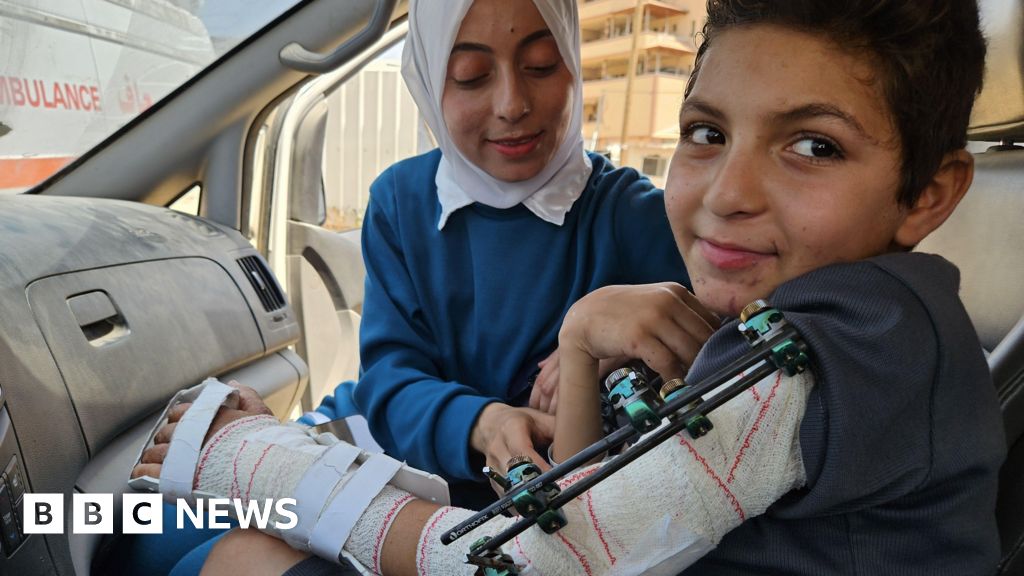ARTICLE AD BOX
By Hugh Schofield
BBC News, Paris
Image source, Simone Probst collection
Image caption,Caroline's adventures first hit the bookshops in 1953, closely followed by Martine
Do you like your childhood heroine to be the type that catches outlaws in the Wild West, can re-plumb and re-roof an entire country home, and once survived a biplane crash in the Arctic?
Or would you rather a girl who cooks biscuits with Mum, enjoys sewing lessons and the occasional game of marbles, and whose idea of an adventure is taking the train to visit cousins in Normandy?
For nearly 70 years, Caroline and Martine have been rivals for the hearts of French schoolchildren.
If you were a more outdoors-type you would have gone for Caroline. She was the first to appear in 1953 for publisher Hachette.
Created by artist Pierre Probst, she wore red dungarees and led an adult-free existence with a gang of eight animal friends: two cats, three dogs, a bear, a lion and a panther.
Such was her success that a year later rival publishing house Casterman dreamed up Martine with artist Marcel Marlier.
Martine books are still on sale in French bookshops in the run-up to Christmas
But while Caroline lived in a magical world where cats drive cars and 10-year old girls can travel the countryside at the head of their own circus, Martine was firmly attached to the domestic apron-strings.
A sweet doe-eyed goody-goody, she wore little dresses that revealed occasional glimpses of white cotton underwear. Her world was twee, familiar and painted in an icky soft-focus glow.
Caroline rode a bucking bronco. Martine baked a cake.
Image source, Simone Probst
Image caption,Caroline on a bucking bronco
Both characters sold albums in their millions and were translated into dozens of languages. But only one made it into the Schofield family in the 1970s, and it certainly was not Martine.
At some point an English-language album containing five of the stories was published: Caroline at the North Pole, in Europe, on a ranch, camping and winter sports.
It found its way into our home and we were entranced.
With her blonde bunches and irrepressible good cheer, Caroline was the head of a household whose other occupants were her eight anthropomorphic chums.
Image source, Simone Probst
Image caption,Caroline was very much the animals' leader
The animals - named Puff, Blacko, Boom, Chippy, Mops, Bobby, Kid and Dapply - spoke and wore clothes, walked on two legs and generally acted as humans. Caroline was their mother and leader, initiating, organising and helping them through scrapes.
Two things made the Caroline books stand out. The first was the thrilling confusion between the worlds of children and adults.
Caroline was only about 10, but she could do whatever she wanted, such as buy a house, charter a ship for the Arctic or become a history teacher. Her friends were likewise endowed with all sorts of grown-up skills, including ski-jumping or laying wallpaper. But they also enjoyed the child-like security of being in a family.
The other part of the magic was Pierre Probst's artistry.
Pierre Probst was born in 1913 in the Alsace town of Mulhouse, which was then part of Germany. His family all worked in printed fabrics, for which the town was famous, and Pierre decided very young that he would be an artist.
Image source, Simone Probst
Image caption,In this early drawing Pierre Probst wrote "I want to become a French soldier"
He trained at Mulhouse art school and in the late 1930s moved to Lyon, where he began a career in commercial design.
When World War Two began he served with the French army and kept a remarkable sketch diary of his experiences on the front as France collapsed. Those pictures have never been published.
Image source, Simone Probst
Image caption,Probst's war sketches have never been published
Made a prisoner-of-war, he escaped after telling the Germans that he wished to return to civilian life, as a German, in Mulhouse.
Instead he went back to Lyon, and his wife and newly born baby Simone.
After moving to Paris in 1946, Probst was spotted by Hachette for whom he drew a series of animal stories for very young children. Some of them were republished by English children's writer Enid Blyton in the UK.
This was where the public was first introduced to Chippy the cocker spaniel, Mops the mountain shepherd dog and the others.
Then in 1953 Hachette suggested that he create a new series, this time with a child - a boy - at the centre. Pierre demurred. He had a beloved only child of his own, but she was a girl.
Image source, Simone Probst
So the star of the new books would also be a girl: named Caroline after his favourite grandmother but based firmly on Simone.
Now aged 80, Simone Probst is alive and well and living in a suburb of Brussels.
BBC
When I was young, I was a tomboy and a bit of a daredevil. And I had my hair in bunches. So my father decided to make me the model for this new heroine, Caroline
"He made me sit for him for hours on end, as he drew his sketches," Simone said when I met her at her home. "It wasn't so much my face, but he wanted to capture how young girls hold themselves, the positions they assume. It was a bit of a pain. But I adored my father. So I would just take up a book and read."
Today Simone still has the sprightly effervescence that must have inspired her father.
Some of the story-lines came directly from her experience. For example the 1958 camping album was based on a colonie de vacances, or holiday camp, in the foothills of the Alps, and the Probst country home near Chartres features in the 1956 album Caroline's House.
"One year I persuaded my father to take us to Arizona, and that became Caroline at the Ranch," she said.
Image source, Simone Probst
Image caption,Simone with her father Pierre Probst
"There is a scene where Chippy gets pricked by a cactus, and that happened to me. It was a type of cactus which we were told not to stand beside because the moisture in your body will draw the spike. And it did!"
Pierre Probst's greatest gift was for showing the human emotions on the faces of Caroline's animal friends, and Simone can remember her father drawing from a mirror as he himself performed the grimaces and guffaws that he wanted to convey.
For nearly 20 years Probst produced an album a year. Then he paused and resumed in the early 1980s, drawing around 30 more Caroline albums until his death in 2007.
These, however, do not have the classic feel of the earlier work. In addition Probst drew other series for children and illustrated encyclopaedias and history books.
And so what, after all these years, of the rivalry with Martine? Who ended up winning?
By any logic it should be Caroline.
She displays all the characteristics of the modern, self-assertive woman. She is independent, emancipated and in charge.
What's more she is a role model as much for boys as she is for girls. I know. I was that boy.
As for Martine, she kept going until 10 years ago. The original writer of the texts, Gilbert Delahaye, died in 1997 and Marcel Marlier in 2011, but until then the books were churned out at the rate of one a year.
There were some concessions to modernity. Martine started wearing trousers and the sewing bees disappeared, but otherwise she remained the paragon of domestic innocence. Feminist groups periodically complained, and parodies of Martine covers proliferated mischievously online.
Strange to relate, this Christmas in 2021 it is Martine books that are still on sale in French bookshops.
Image source, Getty Images
Image caption,Belgian artist and illustrator Marcel Marlier died in 2010 but his Martine books live on
Caroline is out of print, with no prospects of being revived.
Martine the home-builder has won - a victory that speaks volumes about the power of nostalgia in French society.
"I feel heartsick when I think of it," said Simone Probst. "Martine is the exact opposite of Caroline. She is homey, tame, unexciting and her adventures aren't adventures. They're just day-to-day events. I'm too old to care much about it now, but really!"

 3 years ago
54
3 years ago
54








 English (US) ·
English (US) ·